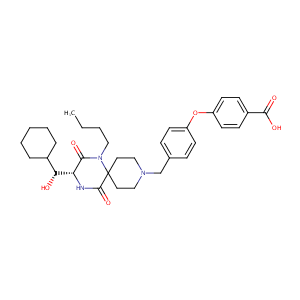Details of the Drug
General Information of Drug (ID: DMG6TS2)
| Drug Name |
GW873140
|
||||||||||||||||||||||
|---|---|---|---|---|---|---|---|---|---|---|---|---|---|---|---|---|---|---|---|---|---|---|---|
| Synonyms |
Aplaviroc; Aplaviroc HCl; Aplaviroc hydrochloride; AK 602; AK602; GSK873140; GW 873140; ONO 4128; AK-602; Aplaviroc hydrochloride (USAN); GW-873140; ONO-4128; Benzoic acid, 4-[4-[[1-butyl-3-[(R)-cyclohexylhydroxymethyl]-2,5-dioxo-1,4,9-triazaspiro[5.5]undec-9-yl]methyl]phenoxy]-& Soluble CD4; 4-[4-[[(9R)-11-butyl-9-[(R)-cyclohexyl(hydroxy)methyl]-7,10-dioxo-3,8,11-triazaspiro[5.5]undecan-3-yl]methyl]phenoxy]benzoic acid; 4-[4-[[(9R)-11-butyl-9-[(R)-cyclohexyl(hydroxy)methyl]-7,10-dioxo-3,8,11-triazaspiro[5.5]undecan-3-yl]methyl]phenoxy]benzoic acid hydrochloride; 873140 Compound
|
||||||||||||||||||||||
| Indication |
|
||||||||||||||||||||||
| Drug Type |
Small molecular drug
|
||||||||||||||||||||||
| Structure |
 |
||||||||||||||||||||||
| 3D MOL | 2D MOL | ||||||||||||||||||||||
| #Ro5 Violations (Lipinski): 1 | Molecular Weight (mw) | 577.7 | |||||||||||||||||||||
| Logarithm of the Partition Coefficient (xlogp) | 3.1 | ||||||||||||||||||||||
| Rotatable Bond Count (rotbonds) | 10 | ||||||||||||||||||||||
| Hydrogen Bond Donor Count (hbonddonor) | 3 | ||||||||||||||||||||||
| Hydrogen Bond Acceptor Count (hbondacc) | 7 | ||||||||||||||||||||||
| Chemical Identifiers |
|
||||||||||||||||||||||
| Cross-matching ID | |||||||||||||||||||||||
Molecular Interaction Atlas of This Drug
 Drug Therapeutic Target (DTT) |
|
|||||||||||||||||||||||||||||||
|---|---|---|---|---|---|---|---|---|---|---|---|---|---|---|---|---|---|---|---|---|---|---|---|---|---|---|---|---|---|---|---|---|
 Drug-Metabolizing Enzyme (DME) |
|
|||||||||||||||||||||||||||||||
| Molecular Interaction Atlas (MIA) | ||||||||||||||||||||||||||||||||
Molecular Expression Atlas of This Drug
| The Studied Disease | Human immunodeficiency virus-1 infection | |||||||||||||||||||||||||||||||||||
|---|---|---|---|---|---|---|---|---|---|---|---|---|---|---|---|---|---|---|---|---|---|---|---|---|---|---|---|---|---|---|---|---|---|---|---|---|
| ICD Disease Classification | 1C62 | |||||||||||||||||||||||||||||||||||
|
||||||||||||||||||||||||||||||||||||
| Molecular Expression Atlas (MEA) | ||||||||||||||||||||||||||||||||||||
References
